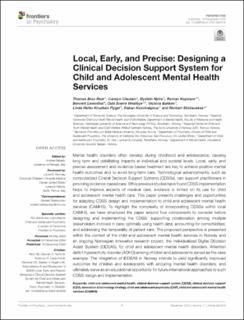| dc.contributor.author | Røst, Thomas Brox | |
| dc.contributor.author | Clausen, Carolyn E. | |
| dc.contributor.author | Øystein, Nytro | |
| dc.contributor.author | Koposov, Roman A | |
| dc.contributor.author | Leventhal, Bennett | |
| dc.contributor.author | Westbye, Odd Sverre | |
| dc.contributor.author | Bakken, Victoria | |
| dc.contributor.author | Flygel, Linda | |
| dc.contributor.author | Koochakpour, Kaban | |
| dc.contributor.author | Skokauskas, Norbert | |
| dc.date.accessioned | 2021-01-04T16:13:12Z | |
| dc.date.available | 2021-01-04T16:13:12Z | |
| dc.date.created | 2020-11-25T10:54:51Z | |
| dc.date.issued | 2020 | |
| dc.identifier.issn | 1664-0640 | |
| dc.identifier.uri | https://hdl.handle.net/11250/2721350 | |
| dc.description.abstract | Mental health disorders often develop during childhood and adolescence, causing long term and debilitating impacts at individual and societal levels. Local, early, and precise assessment and evidence-based treatment are key to achieve positive mental health outcomes and to avoid long-term care. Technological advancements, such as computerized Clinical Decision Support Systems (CDSSs), can support practitioners in providing evidence-based care. While previous studies have found CDSS implementation helps to improve aspects of medical care, evidence is limited on its use for child and adolescent mental health care. This paper presents challenges and opportunities for adapting CDSS design and implementation to child and adolescent mental health services (CAMHS). To highlight the complexity of incorporating CDSSs within local CAMHS, we have structured the paper around four components to consider before designing and implementing the CDSS: supporting collaboration among multiple stakeholders involved in care; optimally using health data; accounting for comorbidities; and addressing the temporality of patient care. The proposed perspective is presented within the context of the child and adolescent mental health services in Norway and an ongoing Norwegian innovative research project, the Individualized Digital DEcision Assist System (IDDEAS), for child and adolescent mental health disorders. Attention deficit hyperactivity disorder (ADHD) among children and adolescents serves as the case example. The integration of IDDEAS in Norway intends to yield significantly improved outcomes for children and adolescents with enduring mental health disorders, and ultimately serve as an educational opportunity for future international approaches to such CDSS design and implementation. | en_US |
| dc.language.iso | eng | en_US |
| dc.publisher | Frontiers Media | en_US |
| dc.rights | Navngivelse 4.0 Internasjonal | * |
| dc.rights.uri | http://creativecommons.org/licenses/by/4.0/deed.no | * |
| dc.title | Local, Early, and Precise: Designing a Clinical Decision Support System for Child and Adolescent Mental Health Services | en_US |
| dc.type | Peer reviewed | en_US |
| dc.type | Journal article | en_US |
| dc.description.version | publishedVersion | en_US |
| dc.source.volume | 11 | en_US |
| dc.source.journal | Frontiers in Psychiatry | en_US |
| dc.identifier.doi | https://doi.org/10.3389/fpsyt.2020.564205 | |
| dc.identifier.cristin | 1852103 | |
| dc.description.localcode | Copyright © 2020 Røst, Clausen, Nytrø, Koposov, Leventhal, Westbye, Bakken, Flygel, Koochakpour and Skokauskas. This is an open-access article distributed under the terms of the Creative Commons Attribution License (CC BY). The use, distribution or reproduction in other forums is permitted, provided the original author(s) and the copyright owner(s) are credited and that the original publication in this journal is cited, in accordance with accepted academic practice. No use, distribution or reproduction is permitted which does not comply with these terms. | en_US |
| cristin.ispublished | true | |
| cristin.fulltext | original | |
| cristin.qualitycode | 1 | |

